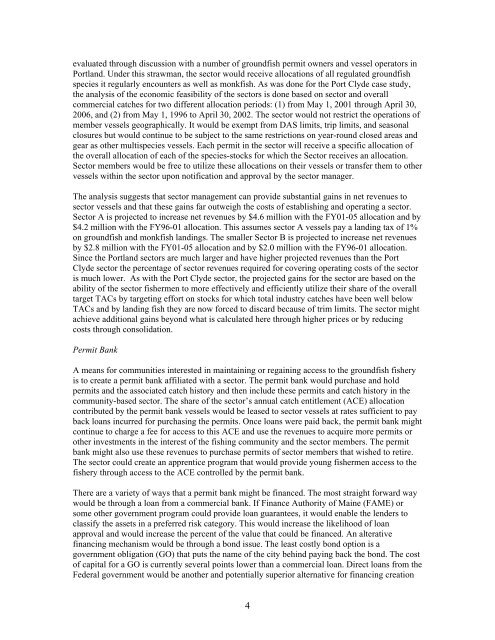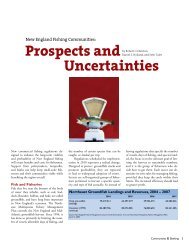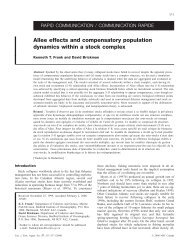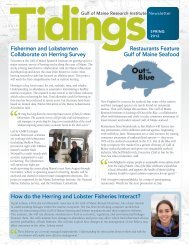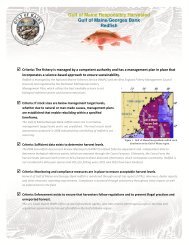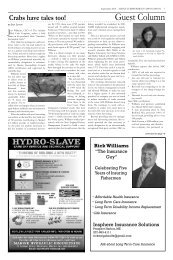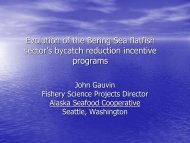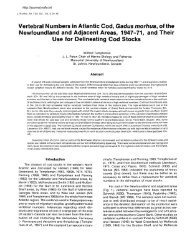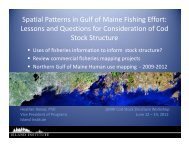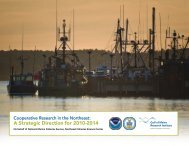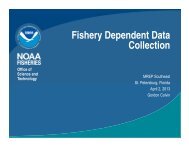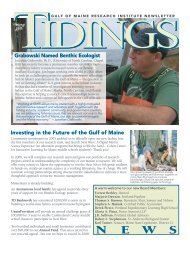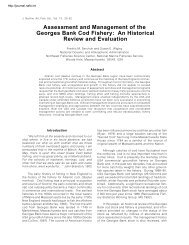Community-based Sectors for the New England Groundfish Fishery
Community-based Sectors for the New England Groundfish Fishery
Community-based Sectors for the New England Groundfish Fishery
You also want an ePaper? Increase the reach of your titles
YUMPU automatically turns print PDFs into web optimized ePapers that Google loves.
evaluated through discussion with a number of groundfish permit owners and vessel operators in<br />
Portland. Under this strawman, <strong>the</strong> sector would receive allocations of all regulated groundfish<br />
species it regularly encounters as well as monkfish. As was done <strong>for</strong> <strong>the</strong> Port Clyde case study,<br />
<strong>the</strong> analysis of <strong>the</strong> economic feasibility of <strong>the</strong> sectors is done <strong>based</strong> on sector and overall<br />
commercial catches <strong>for</strong> two different allocation periods: (1) from May 1, 2001 through April 30,<br />
2006, and (2) from May 1, 1996 to April 30, 2002. The sector would not restrict <strong>the</strong> operations of<br />
member vessels geographically. It would be exempt from DAS limits, trip limits, and seasonal<br />
closures but would continue to be subject to <strong>the</strong> same restrictions on year-round closed areas and<br />
gear as o<strong>the</strong>r multispecies vessels. Each permit in <strong>the</strong> sector will receive a specific allocation of<br />
<strong>the</strong> overall allocation of each of <strong>the</strong> species-stocks <strong>for</strong> which <strong>the</strong> Sector receives an allocation.<br />
Sector members would be free to utilize <strong>the</strong>se allocations on <strong>the</strong>ir vessels or transfer <strong>the</strong>m to o<strong>the</strong>r<br />
vessels within <strong>the</strong> sector upon notification and approval by <strong>the</strong> sector manager.<br />
The analysis suggests that sector management can provide substantial gains in net revenues to<br />
sector vessels and that <strong>the</strong>se gains far outweigh <strong>the</strong> costs of establishing and operating a sector.<br />
Sector A is projected to increase net revenues by $4.6 million with <strong>the</strong> FY01-05 allocation and by<br />
$4.2 million with <strong>the</strong> FY96-01 allocation. This assumes sector A vessels pay a landing tax of 1%<br />
on groundfish and monkfish landings. The smaller Sector B is projected to increase net revenues<br />
by $2.8 million with <strong>the</strong> FY01-05 allocation and by $2.0 million with <strong>the</strong> FY96-01 allocation.<br />
Since <strong>the</strong> Portland sectors are much larger and have higher projected revenues than <strong>the</strong> Port<br />
Clyde sector <strong>the</strong> percentage of sector revenues required <strong>for</strong> covering operating costs of <strong>the</strong> sector<br />
is much lower. As with <strong>the</strong> Port Clyde sector, <strong>the</strong> projected gains <strong>for</strong> <strong>the</strong> sector are <strong>based</strong> on <strong>the</strong><br />
ability of <strong>the</strong> sector fishermen to more effectively and efficiently utilize <strong>the</strong>ir share of <strong>the</strong> overall<br />
target TACs by targeting ef<strong>for</strong>t on stocks <strong>for</strong> which total industry catches have been well below<br />
TACs and by landing fish <strong>the</strong>y are now <strong>for</strong>ced to discard because of trim limits. The sector might<br />
achieve additional gains beyond what is calculated here through higher prices or by reducing<br />
costs through consolidation.<br />
Permit Bank<br />
A means <strong>for</strong> communities interested in maintaining or regaining access to <strong>the</strong> groundfish fishery<br />
is to create a permit bank affiliated with a sector. The permit bank would purchase and hold<br />
permits and <strong>the</strong> associated catch history and <strong>the</strong>n include <strong>the</strong>se permits and catch history in <strong>the</strong><br />
community-<strong>based</strong> sector. The share of <strong>the</strong> sector’s annual catch entitlement (ACE) allocation<br />
contributed by <strong>the</strong> permit bank vessels would be leased to sector vessels at rates sufficient to pay<br />
back loans incurred <strong>for</strong> purchasing <strong>the</strong> permits. Once loans were paid back, <strong>the</strong> permit bank might<br />
continue to charge a fee <strong>for</strong> access to this ACE and use <strong>the</strong> revenues to acquire more permits or<br />
o<strong>the</strong>r investments in <strong>the</strong> interest of <strong>the</strong> fishing community and <strong>the</strong> sector members. The permit<br />
bank might also use <strong>the</strong>se revenues to purchase permits of sector members that wished to retire.<br />
The sector could create an apprentice program that would provide young fishermen access to <strong>the</strong><br />
fishery through access to <strong>the</strong> ACE controlled by <strong>the</strong> permit bank.<br />
There are a variety of ways that a permit bank might be financed. The most straight <strong>for</strong>ward way<br />
would be through a loan from a commercial bank. If Finance Authority of Maine (FAME) or<br />
some o<strong>the</strong>r government program could provide loan guarantees, it would enable <strong>the</strong> lenders to<br />
classify <strong>the</strong> assets in a preferred risk category. This would increase <strong>the</strong> likelihood of loan<br />
approval and would increase <strong>the</strong> percent of <strong>the</strong> value that could be financed. An alterative<br />
financing mechanism would be through a bond issue. The least costly bond option is a<br />
government obligation (GO) that puts <strong>the</strong> name of <strong>the</strong> city behind paying back <strong>the</strong> bond. The cost<br />
of capital <strong>for</strong> a GO is currently several points lower than a commercial loan. Direct loans from <strong>the</strong><br />
Federal government would be ano<strong>the</strong>r and potentially superior alternative <strong>for</strong> financing creation<br />
4


